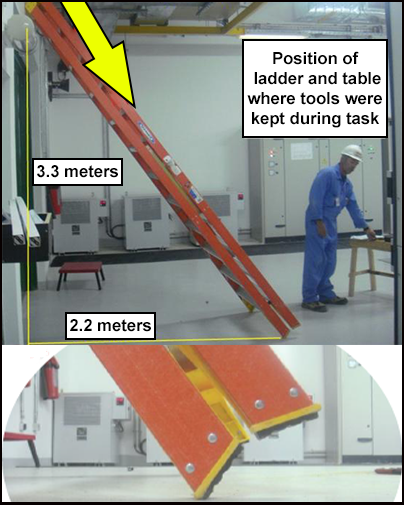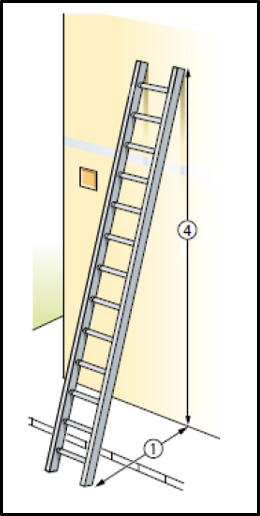-
What happened?
To replace an emergency light, a technician and his colleague mounted a 3.6m/12ft step ladder against a wall.
The first technician climbed the ladder while his colleague held it secure.
He asked his colleague to pass him some tools from a nearby table.
While his colleague went to get the tools, the ladder suddenly slipped and the technician fell.
He received serious facial injuries, for which he required treatment in hospital.

-
Why did it happen?
The stepladder was designed to be used standalone with its spreaders locked, and not leant against a wall. It was too tall to be used as designed in the space available.
Stepladder feet had minimal contact with the floor.
Even if a correct type of stepladder had been used, stepladder was not placed according to 4:1 ratio rule.
No formal risk assessment was done for the job and no safety precautions were included in the instructions.
The task was unsupervised.
Preventive maintenance was covered by a short permit, which is not monitored in the permit to work register.

-
What did they learn?
Before working on ladders, ensure that:
- a risk analysis has been conducted and approved by a supervisor.
- you understand the risks and limitations of the job.
- you take precautions to prevent dropped objects (i.e. tools).
Use the correct type of ladder, and in the correct way.
If you use fall protective equipment, ensure you are trained to do so.
Supervisors should receive risk assessment training from certified trainers.
List and reassess risks for all operations covered by short permits or verbal authorisations.

-
Ask yourself or your crew
Why do you think the workers did what they did?
What could they have done differently?
How do you know which type of ladder you should use for the task?
What makes a good job risk assessment?
How can we prevent something like this happening here?

Add to homescreen
Content name
Select existing category:
Content name
New collection
Edit collection
What happened?
To replace an emergency light, a technician and his colleague mounted a 3.6m/12ft step ladder against a wall.
The first technician climbed the ladder while his colleague held it secure.
He asked his colleague to pass him some tools from a nearby table.
While his colleague went to get the tools, the ladder suddenly slipped and the technician fell.
He received serious facial injuries, for which he required treatment in hospital.
Why did it happen?
The stepladder was designed to be used standalone with its spreaders locked, and not leant against a wall. It was too tall to be used as designed in the space available.
Stepladder feet had minimal contact with the floor.
Even if a correct type of stepladder had been used, stepladder was not placed according to 4:1 ratio rule.
No formal risk assessment was done for the job and no safety precautions were included in the instructions.
The task was unsupervised.
Preventive maintenance was covered by a short permit, which is not monitored in the permit to work register.

What did they learn?
Before working on ladders, ensure that:
- a risk analysis has been conducted and approved by a supervisor.
- you understand the risks and limitations of the job.
- you take precautions to prevent dropped objects (i.e. tools).
Use the correct type of ladder, and in the correct way.
If you use fall protective equipment, ensure you are trained to do so.
Supervisors should receive risk assessment training from certified trainers.
List and reassess risks for all operations covered by short permits or verbal authorisations.

Ask yourself or your crew
Why do you think the workers did what they did?
What could they have done differently?
How do you know which type of ladder you should use for the task?
What makes a good job risk assessment?
How can we prevent something like this happening here?
To replace an emergency light, a technician and his colleague mounted a 3.6m/12ft step ladder against a wall. While his colleague went to get the tools, the ladder suddenly slipped and the technician fell. He received serious facial injuries, for which he required treatment in hospital.











